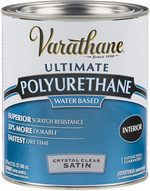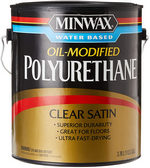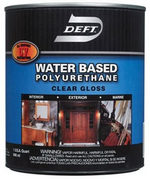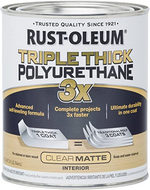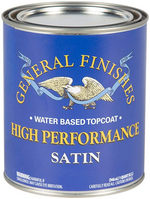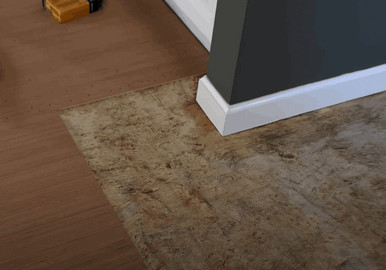Protect Your Hardwood Floors With These Water-Based Polyurethane Finish
Water-based polyurethane offers great protection for floors and is known for its durable hardwood finish. Water-based poly has grown popular since it is a safer option with fewer VOCs than oil-based polys. Choosing the best water-based polyurethane for floors will depend on your needs and other factors.
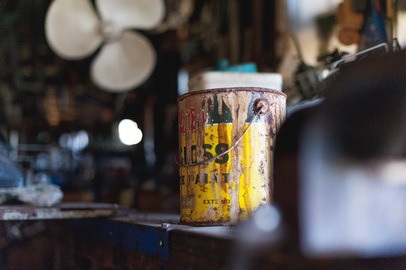
In this guide, we will discuss how to choose the best water-based poly that brings out the beauty of the wood. We also share our top picks of the best water-based polyurethane finish and where you can buy them.
In this guide, we will discuss how to choose the best water-based poly that brings out the beauty of the wood. We also share our top picks of the best water-based polyurethane finish and where you can buy them.
# Our Top Pick for the Best Water-Based Polyurethane Finish for Hardwood Floors
You can’t use just any polyurethane finish and expect smooth, even coats. So when it comes to water-based polyurethane, we’ve found our top choices.
All these water-based poly finishes are ideal for applying coating and stains and are well-suited for various projects.
Its clear appearance makes it a highly versatile poly for a range of projects including floors and cabinets. Although many users have commented on how it turns noticeably yellowish against white wood, more people are satisfied with its results.
Once fully hardened, it resists scratches very well which makes it a great topcoat for homes with children or pets. It is also low odor making it ideal for applying indoors but should still be used in a well-ventilated area.
The small can runs a bit costly but the size is rarely found at local stores, so most users buy this for small and special projects.
Overall, the Varathane satin finish is very easy to work with and is a great product to top off a painted finish.
| Pros | Cons |
| + Leaves a gorgeous soft shine | – A little bit more costly than other polyacrylics |
| + Easy to sand between coats | – Dry time can be too fast so it needs getting used to |
| + Very easy to wash up with soap and water | – Goes very thin so it requires 3-4 coats |
| + Provides excellent coverage | – Some users reported yellowing against white surfaces |
| + Clear topcoat for a natural look | |
| + Water-based so it has a lower VOCs | |
| + No stinky odor from fumes | |
| + Scratch-resistant |
There are some less than stellar reviews on this product primarily because of its fast drying convenience. Although its fast-drying action saves time, a few users commented that the finish dries so quickly that it was impossible to get the surface to look completely smooth without the brush marks. This is clearly a situation where the feature is both a blessing and a curse and the results depend on the user.
This water-based oil-modified poly lends a beautiful golden finish to any surface, especially with whiteboards.
So if you are looking for the amber tint of the traditional oil-based poly with no fumes and has a fast drying time, then this product is for you. It seems to have all the benefits of both water-based and oil-based poly without any of their disadvantages.
| Pros | Cons |
| + Easy to apply | – Hard to find in local stores |
| + Quick-drying action | – Not for users looking for a clear poly |
| + Cleans up very easily with soap and water | – Does not look satin, more like semi-gloss |
| + Non-flammable | – Takes more than 24 hours to cure for durability |
| + Resistant to UV rays, scratches, and chemical damage |
It has a 100% urethane water-based clear protective topcoat with a strong dose of UV blockers to keep it from yellowing under the sun. Its UV resistant feature also means it does not peel or flake over time. It is a versatile water-based oil-modified poly that contains low levels of VOC, so it’s environment-friendly.
Some users recommend this product because of its sanding feature where it self-primes, however, two users also commented that you have to sand it after the first coat because it raises the wood grain.
It is an expensive poly, still many users found it worth every penny because of its glass-like finish. It also reportedly does not turn yellow when tried on oak, poplar, maple, and pine wood.
| Pros | Cons |
| + Can be used on both interior and exterior surfaces | – Can be hard to apply without getting some brush strokes |
| + It is more durable than water-based poly | |
| + It only takes 2 hours for recoating | |
| + It has a low odor and low levels of VOCs | |
| + Protects against damaging effects of UV rays |
People also found this poly to have a good matte finish, even better than other matte water-based formulas in the market. They liked that it has enough shine to bring out the beauty of the wood without being glaring.
Other features that users commented positively on is its unbeatable protection on wooden surfaces, especially floors, which means it is resistant to scratches and stains. Since this is a water-base poly, it is also easy to clean up after use and has almost no odor.
Some people had a little difficulty applying it using a brush because it becomes clumpy, but most don’t seem to have this issue. If they do they managed to resolve this by using a high-density foam roller. Another problem reported is it does not self-level that much and would show the paintbrush strokes.
In terms of pricing, the Rust-Oleum is costlier than the rest of the water-based poly on this list, but users find it an excellent value for money based on the results they get.
| Pros | Cons |
| + One-coat coverage | – Costlier than most water-based poly |
| + Real matte-finish for a natural look | – Difficult to apply using a brush |
| + Fast-drying | – May show brush strokes |
| + Low odor and levels of VOCs | |
| + Resistant to scratches and stains |
General Finishes Water-based topcoat is a highly rated product because of its UV stabilizing properties. The UV resistance features mean it will not easily break down when exposed to sunlight and effectively protects the stained wood underneath from fading.
The best thing that users liked is its versatility when it comes to the brush type. It can be used in any type of brush and still produces a high-quality finish. One user used a roller to apply three light coats then allowed it to dry for 2 hours while softly sanding in between coats.
Like most of the water-based poly in this list, this product doesn’t emit any strong odor which makes it convenient to use inside the house even with kids nearby. The only complaint we found on this water-based poly is its tendency to produce a yellow tinge against white or light paints. Other than this, this product is a top-notch product.
| Pros | Cons |
| + Clear finish | – Can leave a yellowish tint |
| + Can be sprayed | |
| + Can be used over chalk paint | |
| + Prevents sun damage |
Our Verdict
When choosing the best water-based polyurethane for flooring it is important to do your homework properly before buying. There’s a lot to consider such as cure time, finish type, ease of application, cost, and most importantly durability. When it comes down to these factors, it’s a case of personal preference.
In order to help you with this, we’ve listed the best 5 polyurethane protective coatings on the market. From our research, we found Deft Interior Exterior Water-Based Polyurethane Finish to be the best among the bunch based on user reviews and ratings. People thought it has good features because it is a zero odor water-based poly that is safe to use, great for both indoor and outdoor wood projects, and is true to its finish type. It is also clear and does not show any yellowish hue over time.
# How to choose the best water-based polyurethane for floors?
Water-based polyurethane has become a common choice for a floor finish. It has lower levels of VOCs (Volatile Organic Compounds) than oil-based polyurethane. Even when you know you want a water-based polyurethane finish, there are more things to be considered.
What type of floor finish you want?
One of those is the type of finish you would like. There are four types of water-based polyurethane finish: matte, satin, semi-gloss, and high-gloss.
- Matte has a lower luster so some customers shy away with it. Although matte finish lacks shine it has the advantage of showcasing the natural beauty of wood and shows less wear and tear, and dirt.
- Satin has the right amount of luster that can brighten up a room giving it a clean look. It is not too shiny to expose scuffs and scratches and customers are still able to see the beauty in the wood grain.
- Semi-gloss lies in the middle but is shinier than satin. This is typically the shiniest customers are willing to go for their hardwood floors. The gloss this brings requires more maintenance to keep the floors looking good for a long time.
- High-gloss has the most shine but is rarely used on floors with high foot traffic. Generally, this finish is used on specialty floors that are less frequented because its gloss shows everything: dirt, scratches, scuffs, and other signs of wear and tear.
Where is the floor located?
Although most water-based polyurethanes can be used indoors, it is not advisable to use an indoor polyurethane for outdoor flooring since they lack the additives that protect floors from UV rays. When choosing a water-based polyurethane finish, make sure to pay attention to its specification.
What is your method of application?
Every polyurethane has its method of application, typically a brush or a cloth. Some also come in spray cans.
One of our favorite applications is with a paintbrush since it gives a smoother and more even coat on flat surfaces. Brushes can also hold a large amount of finish to coat projects in less time.
Wipe-on polyurethanes are commonly used for contoured surfaces where brushing is not feasible such as crown molding and stair balusters. However, they also form thin coats which means they aren’t advisable in more frequented areas.
Spray polyurethanes are typically used for hard-to-reach surfaces such as chair spindles and shutter louvers. They easily drip and require extra work to protect wood surfaces from overspray. Like wipe-on polys, they also create thinner coats which means they aren’t as tough as the ones you brush-on.
For an entire room bulk finish, we recommend using a T-bar/roller. Here is a video on how to apply water based polyurethane with a T-bar applicator.
What kind of surface do you plan to apply the poly?
Water-based poly is best used for gray stained, white stained, or a white-washed hardwood floor. It is also recommended to coat very light pieces of wood such as Maple and hardwoods with a yellowish tone such as Ash, Pine, or Fir.
# What are the benefits of water-based polyurethane?
- It retains the natural beauty of the wood. Unlike oil-based poly that takes on an amber hue that darkens over time, water-based poly is clear which means it will remain clear for the lifetime of the hardwood floor.
- It has faster drying times. With water-based poly, you can apply up to 4 coats in one day and can be walked on 4 to 6 hours after the last coat. In comparison, one coat of oil-based poly takes 24 hours to dry and cure.
- It has almost no smell. This means it is safe to apply and will not stink up the house. Water-based poly also has lower levels of VOCs, so you can apply it even when your family is around the house or apartment.
# How to apply water-based polyurethane finish?
Carefully follow the steps on how to apply water-based polyurethane on hardwood floors properly. Incorrect use can be expensive and a waste of time.
- Sand the surface with fine grits of sandpaper, so your floor accepts the coating liquid smoothly. Most projects require progressive sanding using 100 grit, 150 grit, and extra sanding with a 220 grit sandpaper. You also have to make sure the hardwood floor should be dry when sanding.
- Remove the dust after sanding. You can use a vacuum with a soft brush followed by a clean and lint-free cloth.
- Mix the polyurethane into one large container for a durable coating. Stir it gently for 5-10 seconds to remove bubbles. It is also important to have enough polyurethane to coat the entire area so you don’t run out of liquid in the middle of your work.
- You need at least three coats of water-based poly for lightly used surfaces and at least four coats for projects that require maximum protection.
- The initial coat should be dry in 3-4 hours. When the coat is fully dry, softly sand between coats with 220 grit sandpaper and wipe the dust with a microfiber cloth before applying the second coat.
- Do the same for the third and fourth coating.
- As you’re finishing, check your work with a bright side-light to see imperfections. You can fix bubbles, bumps, or ugly brush marks when the finish is still wet but not once it starts to set up and dry.
# Tips when using water-based polyurethane
- Wear protective clothing and equipment.
- Keep your children and pets away while coating and when it’s still drying.
- Do not use excessive pressure while coating.
- Never shake a can of polyurethane to prevent bubbles.
- Apply the water-based finish in a well-ventilated area.
- Stir the water-based poly before applying each layer to remove bubbles.
- Seal oil-based stain with dewaxed shellac first before using water-based poly.
- The brush should always move in the direction of the grain.
- Raise the grain of the wood by sanding the surface and wetting it down with a damp rag.
There really weren’t that many negative comments about this poly and is very well-liked by many that bought and used it. It definitely does its job and is a great value for money.
With this, we’ve come to the end of this review guide and we hope our efforts help you find the right water-based product for your flooring projects. Let us know your favorites by commenting below.
